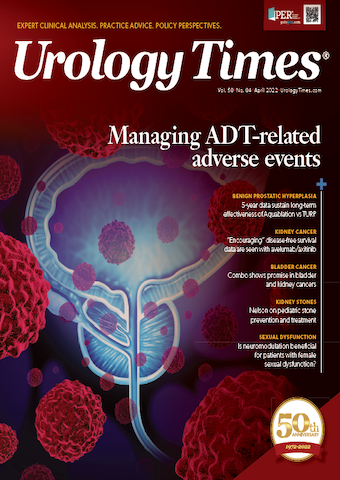Publication
Article
Urology Times Journal
Niraparib/Cabozantinib combo shows promise in bladder and kidney cancers
Author(s):
Findings from the phase 1/2 NICARAGUA study shared during the 2022 ASCO Genitourinary Cancers Symposium showed clinical activity with an acceptable safety profile for the combination of the PARP inhibitor niraparib (Zejula) and the multikinase inhibitor cabozantinib (Cabometyx, Cometriq) in patients with metastatic urothelial carcinoma (mUC) or renal cell carcinoma.1
Lead author Daniel E. Castellano, MD, of the Hospital Universitario 12 De Octubre in Madrid, Spain, reported zero dose-limiting toxicities (DLTs) for dose level (DL) 1 (n = 5), stomatitis at DL 1.1 (n = 6), and decreased platelet count and anemia, diarrhea, and hepatotoxicity in DL 2 (n = 8). Two patients achieved partial response, both of whom had mUC, and a total of 17 patients had stable disease. The total clinical benefit rate (CBR) was 82.6%. When stratified by dose level, the CBR for DL 1 was 71.4%, DL 1.1 was 100.0%, and DL 2 was 77.8%.
Patients with UC whose tumors overexpress c-Met may benefit from this unique combination, thus investigators sought to evaluate the maximum tolerated dose (MTD) of the combination in patients with advanced kidney/UC, as well was preliminary efficacy in advanced UC.
Overall, the NICARAGUA trial (NCT03424201) followed a traditional 3 + 3 dose escalation design that measured safety, tolerability, DLT, and MTD. The primary objective of phase 1 was to determine the MTD of niraparib and cabozantinib in patients with advanced UC or renal cell carcinoma. Secondary objectives for phase 1 were to determine the safety profile for the combination at administered dose levels. Phase 2 measured the efficacy of the combination in patients with advanced UC. Phase 2 objectives were to determine the safety profile of the combination at selected dose levels and efficacy based on objective response rate, disease control rate, duration of response, and overall survival.
The planned dose levels for phase 1 were DL 1 niraparib 100 mg and cabozantinib 20 mg; DL 1.1 niraparib 100 mg and cabozantinib 40 mg; DL2 niraparib 200 mg and cabozantinib 20 mg; DL3 niraparib 200 mg and cabozantinib 40 mg; and DL 4 niraparib 200 mg and cabozantinib 60 mg. In phase 2, patients received niraparib and cabozantinib, once daily each, in 28-day cycles at doses recommended in the phase 1 portion. Patients continued with the dose escalation portion of the study until disease progression, a serious life-threatening adverse event, consent withdrawal, or severe noncompliance to the protocol.
Patients were accrued to each dose level in cohorts of 6 until the MTD was achieved, which was defined as the highest dose at which 1 out of 6 patients experience a DLT. DLT was evaluated during the first 2 cycles of treatment.
Patients were eligible for enrollment if they had advanced or metastatic disease not amenable to curative surgery or radiation, UC of the urinary tract that was confirmed by histology (for phase 1 and 2) or renal cell carcinoma (for phase 1), ECOG performance status of 0 or 1, and no prior therapy with PARP or c-MET inhibitors. Twenty-three patients were included in phase 1. Of those, 19 were deemed evaluable for DLT.
Although DLTs were observed in 2 of 6 patients in DL 2, the sponsor and coordinating investigators agreed to include 3 additional patients at this dose level to provide a greater sample size for risk/benefit assessment and to select the most suitable dose for the second phase of the trial.
Regarding safety, the most common toxicities observed were hypertension (31.8%), constipation (31.8%), and asthenia (31.8%), followed by palmar-plantar erythrodysesthesia (27.3%) and platelet count decrease (22.7%). One patient each reported anemia, diarrhea, hepatotoxicity, platelet count decrease, and palmar-plantar erythrodysesthesia, of grade 3 toxicity. No grade 4 or 5 toxicities were reported.
Based on the dose escalation portion of the study, investigators recommended the phase 2 dose as niraparib 100 mg/day plus cabozantinib 40 mg/day. The second phase of the study is now recruiting patients with metastatic UC.
Reference
1. Castellano DE, Duran I, Mellado B, et al. Phase I-II study to evaluate safety and efficacy of niraparib plus cabozantinib in patients with advanced urothelial/kidney cancer (NICARAGUA trial): Preliminary data of phase I study. J Clin Oncol. 2022;40(suppl 6; abstr 490). doi 10.1200/JCO.2022.40.6_suppl.490
































